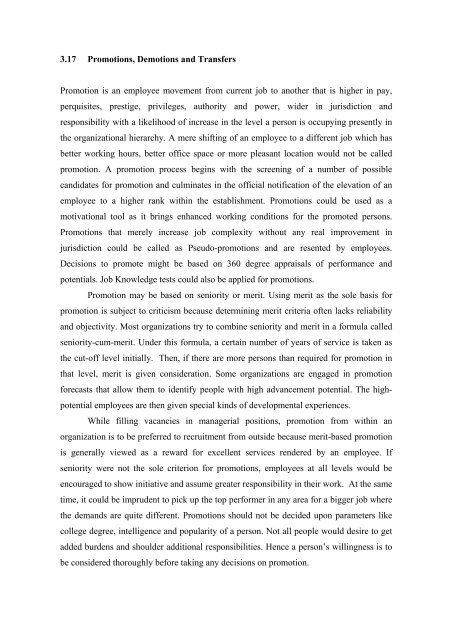UNIT – I Lesson 1 HRM – AN OVERVIEW Lesson Outline Nature of ...
UNIT – I Lesson 1 HRM – AN OVERVIEW Lesson Outline Nature of ...
UNIT – I Lesson 1 HRM – AN OVERVIEW Lesson Outline Nature of ...
Create successful ePaper yourself
Turn your PDF publications into a flip-book with our unique Google optimized e-Paper software.
3.17 Promotions, Demotions and Transfers<br />
Promotion is an employee movement from current job to another that is higher in pay,<br />
perquisites, prestige, privileges, authority and power, wider in jurisdiction and<br />
responsibility with a likelihood <strong>of</strong> increase in the level a person is occupying presently in<br />
the organizational hierarchy. A mere shifting <strong>of</strong> an employee to a different job which has<br />
better working hours, better <strong>of</strong>fice space or more pleasant location would not be called<br />
promotion. A promotion process begins with the screening <strong>of</strong> a number <strong>of</strong> possible<br />
candidates for promotion and culminates in the <strong>of</strong>ficial notification <strong>of</strong> the elevation <strong>of</strong> an<br />
employee to a higher rank within the establishment. Promotions could be used as a<br />
motivational tool as it brings enhanced working conditions for the promoted persons.<br />
Promotions that merely increase job complexity without any real improvement in<br />
jurisdiction could be called as Pseudo-promotions and are resented by employees.<br />
Decisions to promote might be based on 360 degree appraisals <strong>of</strong> performance and<br />
potentials. Job Knowledge tests could also be applied for promotions.<br />
Promotion may be based on seniority or merit. Using merit as the sole basis for<br />
promotion is subject to criticism because determining merit criteria <strong>of</strong>ten lacks reliability<br />
and objectivity. Most organizations try to combine seniority and merit in a formula called<br />
seniority-cum-merit. Under this formula, a certain number <strong>of</strong> years <strong>of</strong> service is taken as<br />
the cut-<strong>of</strong>f level initially. Then, if there are more persons than required for promotion in<br />
that level, merit is given consideration. Some organizations are engaged in promotion<br />
forecasts that allow them to identify people with high advancement potential. The highpotential<br />
employees are then given special kinds <strong>of</strong> developmental experiences.<br />
While filling vacancies in managerial positions, promotion from within an<br />
organization is to be preferred to recruitment from outside because merit-based promotion<br />
is generally viewed as a reward for excellent services rendered by an employee. If<br />
seniority were not the sole criterion for promotions, employees at all levels would be<br />
encouraged to show initiative and assume greater responsibility in their work. At the same<br />
time, it could be imprudent to pick up the top performer in any area for a bigger job where<br />
the demands are quite different. Promotions should not be decided upon parameters like<br />
college degree, intelligence and popularity <strong>of</strong> a person. Not all people would desire to get<br />
added burdens and shoulder additional responsibilities. Hence a person’s willingness is to<br />
be considered thoroughly before taking any decisions on promotion.
















